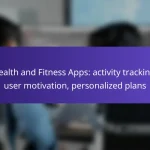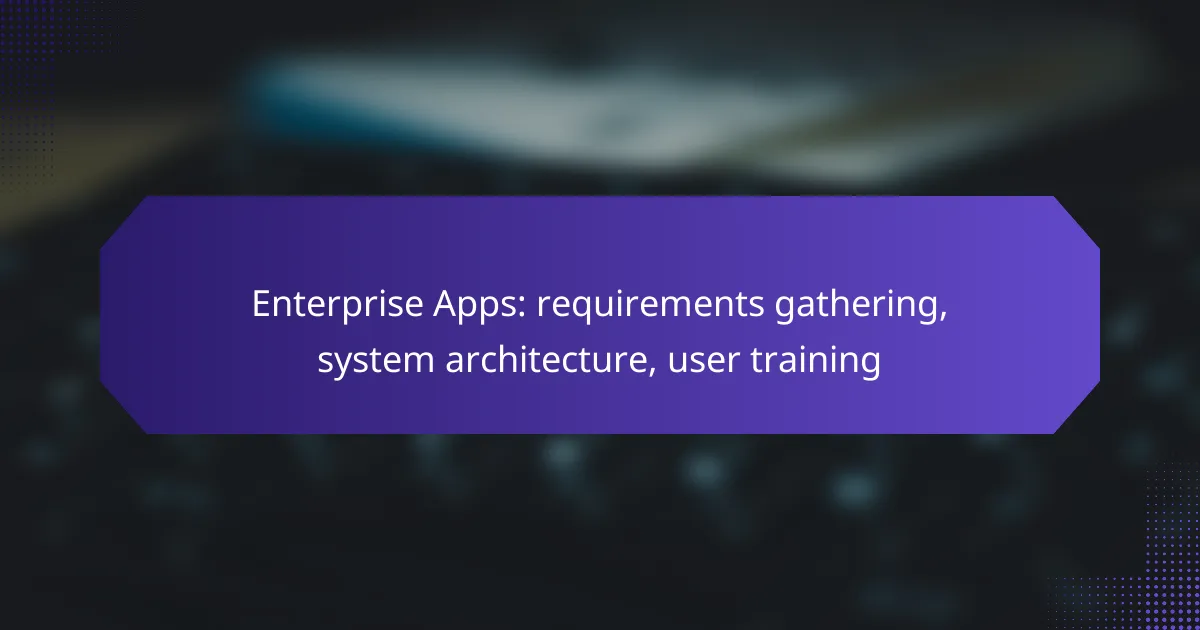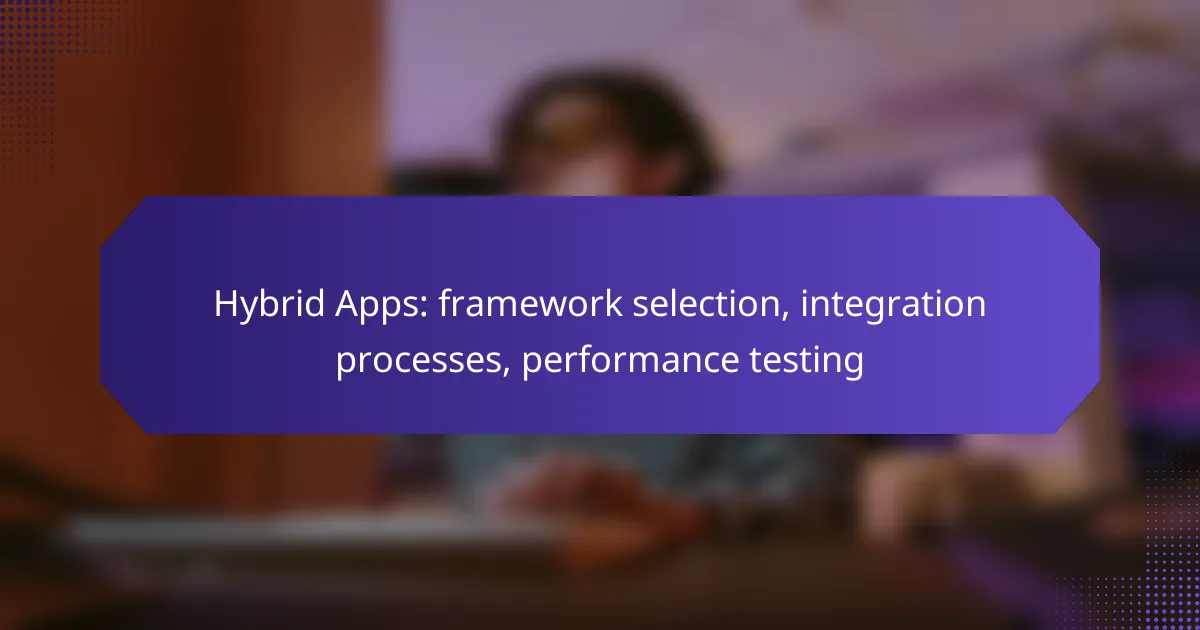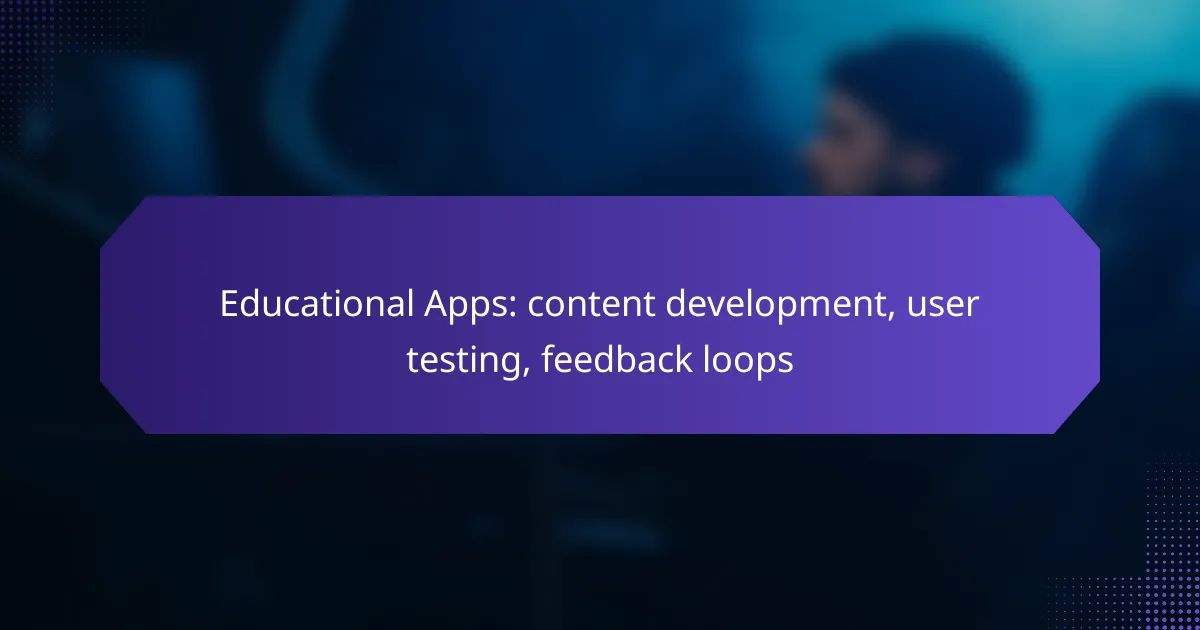In the development of enterprise applications, effective requirements gathering is crucial for aligning stakeholder needs with business objectives. This process involves engaging with users through interviews, workshops, and surveys to ensure a comprehensive understanding of the application’s goals. Additionally, a well-designed system architecture that incorporates microservices and cloud solutions is essential for scalability and security, while user training is vital for maximizing adoption and efficiency.
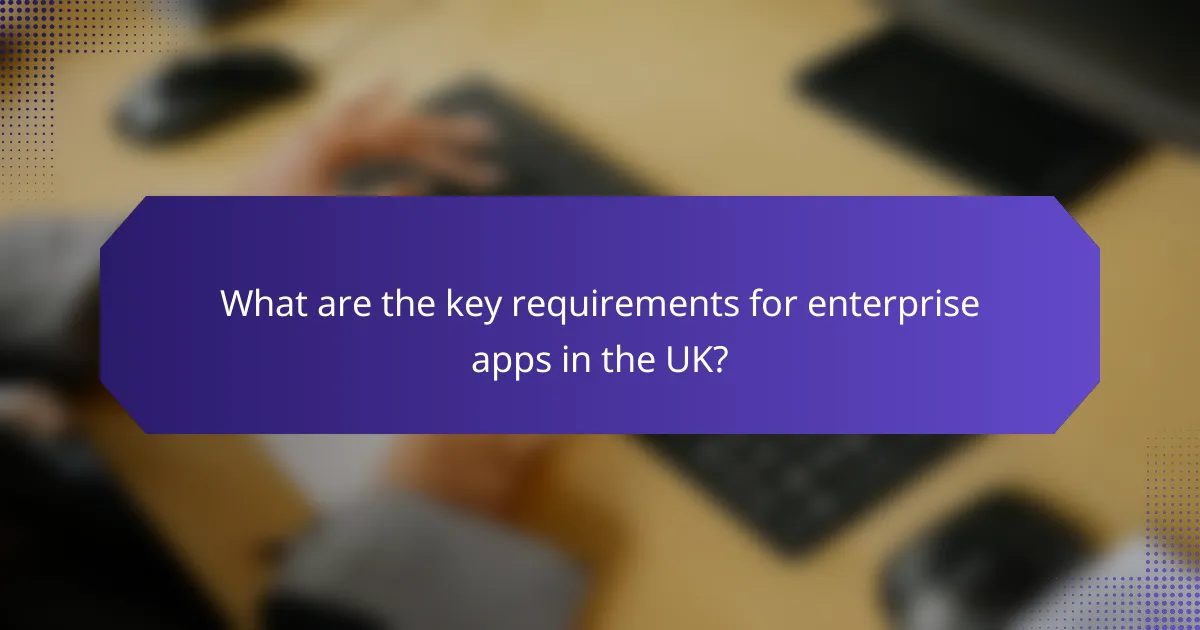
What are the key requirements for enterprise apps in the UK?
Key requirements for enterprise apps in the UK include thorough stakeholder engagement, comprehensive business process analysis, compliance with local regulations, scalability, flexibility, and a strong focus on user experience. Addressing these areas ensures that the application meets both business needs and user expectations.
Stakeholder engagement
Engaging stakeholders is crucial for gathering insights and requirements that reflect the needs of the business. This involves identifying key individuals, such as executives, department heads, and end-users, and involving them throughout the development process. Regular feedback sessions can help align the app’s features with user expectations.
Consider using workshops or interviews to facilitate discussions and gather diverse perspectives. Documenting stakeholder requirements clearly can prevent misunderstandings and ensure that the final product meets the intended goals.
Business process analysis
A thorough analysis of existing business processes is essential for identifying areas where the enterprise app can add value. This involves mapping out workflows, identifying bottlenecks, and understanding how different departments interact. By doing so, you can pinpoint specific functionalities that the app must support.
Utilizing process mapping tools can help visualize workflows and facilitate discussions among stakeholders. Aim to streamline processes through automation and integration, which can lead to increased efficiency and reduced operational costs.
Compliance with regulations
Compliance with UK regulations, such as the General Data Protection Regulation (GDPR) and industry-specific standards, is a critical requirement for enterprise apps. Ensuring that the app adheres to these regulations protects user data and mitigates legal risks. Regular audits and assessments can help maintain compliance throughout the app’s lifecycle.
It’s advisable to consult with legal experts to understand specific compliance requirements relevant to your industry. Incorporating compliance checks into the development process can save time and resources in the long run.
Scalability and flexibility
Enterprise apps must be designed with scalability and flexibility in mind to accommodate future growth and changing business needs. This means selecting a robust architecture that can handle increased user loads and data volumes without compromising performance. Cloud-based solutions often provide the scalability needed for growing organizations.
Consider using modular design principles, which allow for easy updates and feature additions. This approach can help the app adapt to new technologies and business requirements over time.
User experience considerations
Focusing on user experience (UX) is vital for ensuring that the enterprise app is intuitive and easy to use. A well-designed interface can enhance productivity and reduce training time for users. Conducting usability testing with real users can provide valuable insights into how the app can be improved.
Incorporate feedback loops to continuously refine the user experience based on user interactions. Prioritizing accessibility features can also broaden the app’s usability across diverse user groups, ensuring compliance with UK accessibility standards.

How to gather requirements effectively?
Effective requirements gathering involves systematic approaches to ensure all stakeholder needs are identified and documented. Utilizing various techniques such as interviews, workshops, surveys, and prototyping can lead to a comprehensive understanding of what the enterprise application must achieve.
Interviews with stakeholders
Interviews are a direct way to gather detailed insights from key stakeholders. Schedule one-on-one or small group sessions to discuss their needs, expectations, and pain points regarding the current systems or processes.
Prepare open-ended questions that encourage discussion, and take careful notes to capture essential information. Aim for a diverse range of stakeholders, including end-users, managers, and IT staff, to ensure a holistic view.
Workshops for collaborative input
Workshops bring together multiple stakeholders to collaboratively discuss requirements in a structured format. These sessions can foster creativity and help identify needs that may not surface in individual interviews.
Facilitate the workshop with clear objectives and use techniques like brainstorming or affinity diagrams to organize thoughts. Aim for a mix of participants to enhance perspectives and drive consensus on priorities.
Surveys for broader feedback
Surveys are effective for collecting input from a larger audience, especially when time or logistics make individual interviews impractical. Design concise surveys with a mix of quantitative and qualitative questions to gauge user satisfaction and gather suggestions.
Distribute the survey via email or internal platforms, ensuring anonymity to encourage honest feedback. Analyze the results to identify trends and common themes that can inform the requirements process.
Prototyping for validation
Prototyping allows stakeholders to visualize and interact with a preliminary version of the application, helping validate requirements before full-scale development. This iterative approach can uncover misunderstandings and refine needs based on user feedback.
Utilize low-fidelity prototypes, such as wireframes or mockups, to start. Gather feedback through user testing sessions, and be prepared to iterate based on the insights gained. This process can significantly reduce the risk of costly changes later in development.
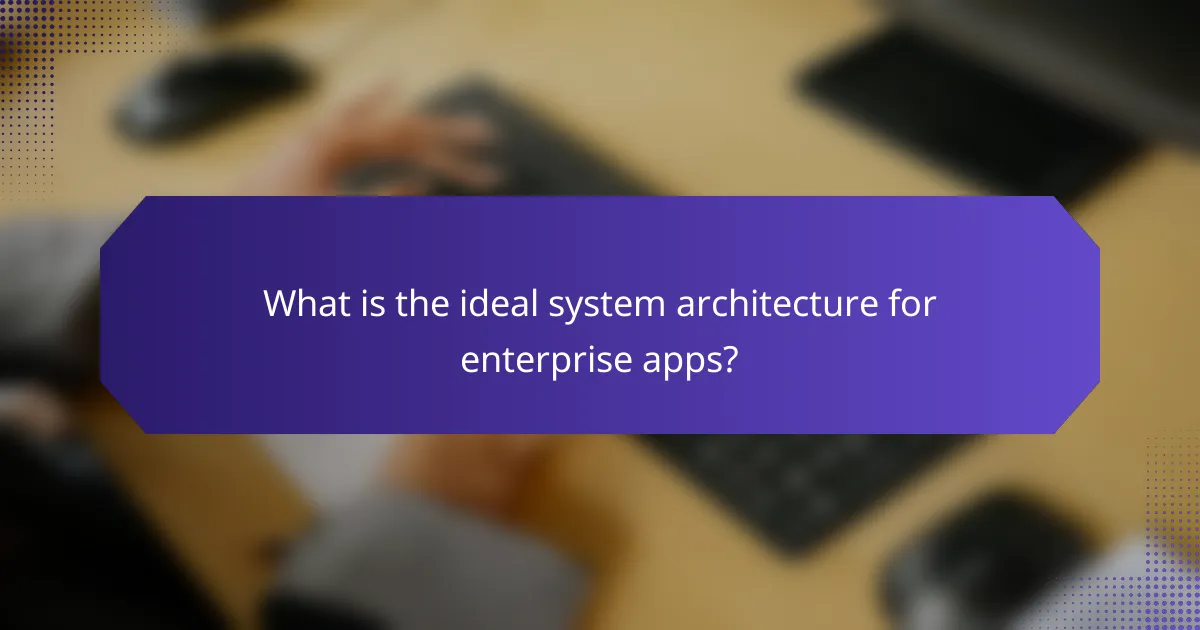
What is the ideal system architecture for enterprise apps?
The ideal system architecture for enterprise apps typically involves a combination of microservices, cloud-based solutions, robust data integration strategies, and strong security frameworks. This architecture allows for scalability, flexibility, and efficient resource management while ensuring data protection and compliance with regulations.
Microservices architecture
Microservices architecture divides an application into small, independent services that can be developed, deployed, and scaled individually. This approach enhances flexibility and allows teams to work on different components simultaneously, reducing time-to-market. However, it requires careful management of inter-service communication and data consistency.
When implementing microservices, consider using containerization tools like Docker and orchestration platforms such as Kubernetes. These technologies facilitate deployment and scaling, making it easier to manage complex applications.
Cloud-based solutions
Cloud-based solutions provide on-demand access to computing resources, enabling enterprises to scale their applications quickly and efficiently. By leveraging Infrastructure as a Service (IaaS) or Platform as a Service (PaaS), organizations can reduce upfront costs and improve operational agility.
When selecting a cloud provider, evaluate factors such as service reliability, compliance with local regulations, and data sovereignty. Popular options include AWS, Microsoft Azure, and Google Cloud, each offering various services tailored to enterprise needs.
Data integration strategies
Effective data integration strategies are crucial for ensuring seamless communication between different systems and applications. Techniques such as API-based integration, ETL (Extract, Transform, Load) processes, and data virtualization help unify data from disparate sources.
Consider adopting a centralized data management platform to streamline integration efforts. This can enhance data accuracy and accessibility, ultimately supporting better decision-making across the organization.
Security frameworks
Implementing robust security frameworks is essential for protecting sensitive enterprise data and maintaining compliance with regulations like GDPR or HIPAA. Key components include identity and access management, encryption, and regular security audits.
To strengthen your security posture, adopt a layered security approach, incorporating firewalls, intrusion detection systems, and employee training on security best practices. Regularly update your security protocols to address emerging threats and vulnerabilities.
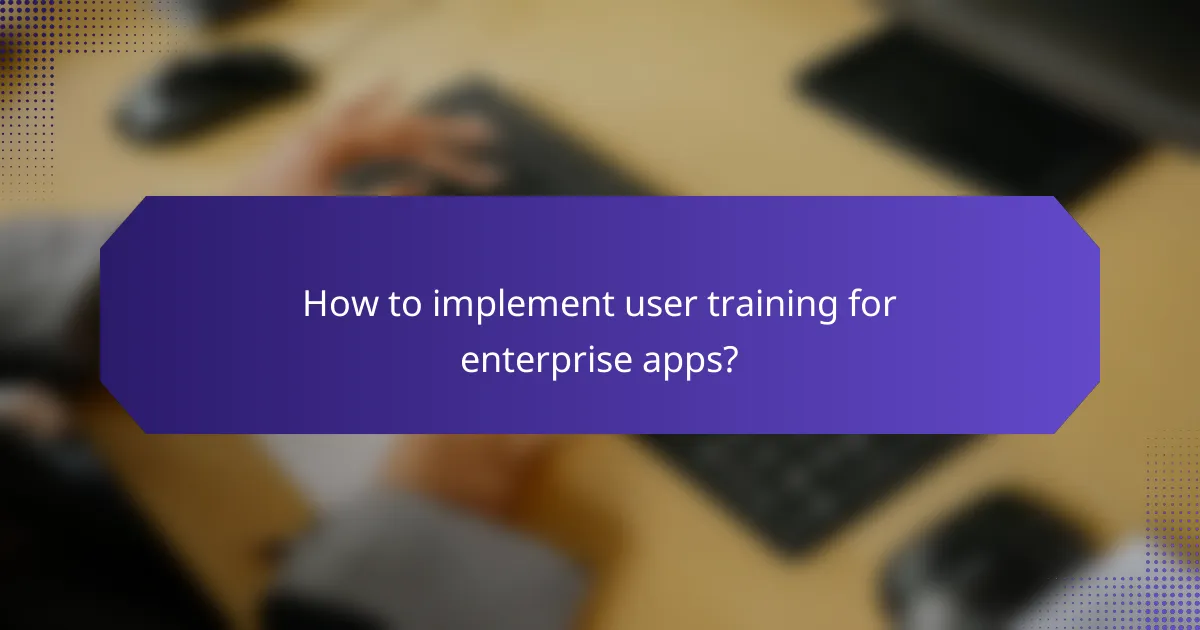
How to implement user training for enterprise apps?
Implementing user training for enterprise apps involves structured onboarding, ongoing support, and interactive training sessions. Effective training ensures users are proficient and comfortable with the app, leading to higher productivity and satisfaction.
Onboarding programs
Onboarding programs are essential for introducing new users to enterprise apps. These programs should include step-by-step guides, video tutorials, and interactive demos to familiarize users with the app’s features and functionalities.
Consider tailoring onboarding content to different user roles, ensuring that each group receives relevant information. A typical onboarding program might last from a few days to a couple of weeks, depending on the app’s complexity.
Ongoing support and resources
Providing ongoing support and resources is crucial for maintaining user engagement and proficiency. Establish a help desk or support team that users can contact for assistance, and create a centralized knowledge base with FAQs, troubleshooting guides, and best practices.
Regularly update these resources to reflect new features or changes in the app. Consider offering a dedicated chat channel or forum where users can share tips and ask questions, fostering a community of support.
Training sessions and workshops
Training sessions and workshops are effective ways to deepen user understanding of enterprise apps. Schedule regular sessions that cover advanced features, use cases, and practical applications, allowing users to ask questions and engage with trainers.
These sessions can be conducted in-person or virtually, accommodating different learning preferences. Aim for sessions that last about one to two hours, ensuring they are interactive and provide hands-on practice.
Feedback mechanisms for improvement
Implementing feedback mechanisms is vital for continuous improvement of user training. Collect user feedback through surveys, focus groups, or informal check-ins to understand their training needs and experiences.
Use this feedback to refine training materials and support resources. Regularly assess the effectiveness of training programs and make adjustments based on user input to ensure they remain relevant and effective.
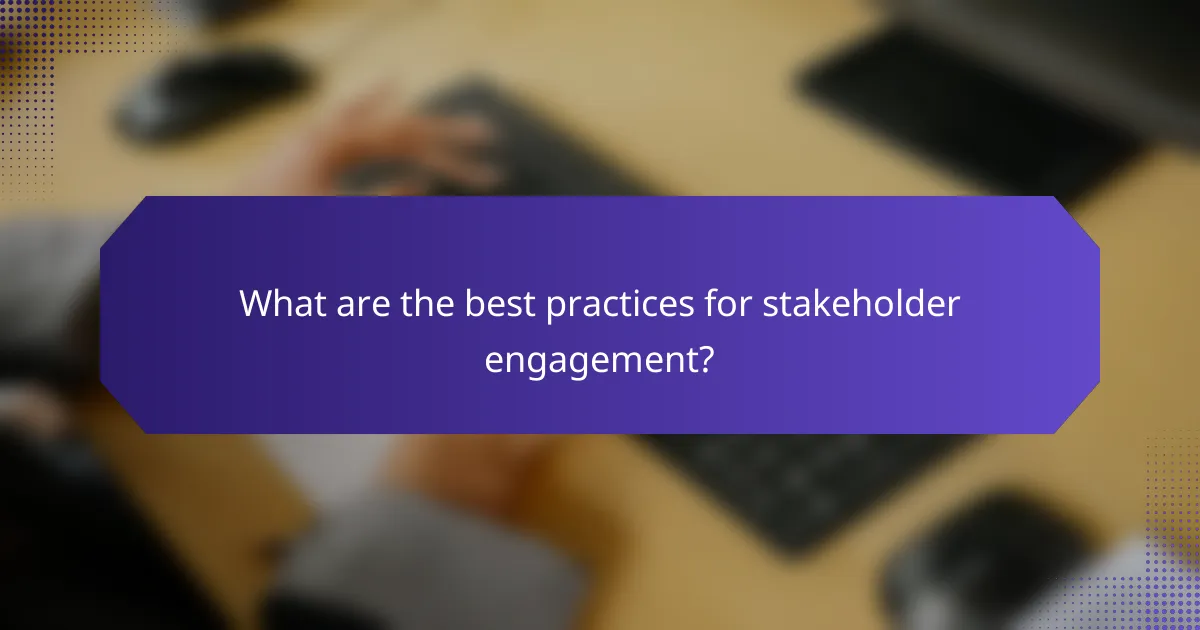
What are the best practices for stakeholder engagement?
Effective stakeholder engagement involves actively involving all relevant parties throughout the project lifecycle. This ensures that their needs and expectations are understood and addressed, leading to better outcomes and satisfaction.
Identify key stakeholders
Identifying key stakeholders is the first step in effective engagement. This includes anyone who will be affected by the project, such as users, management, and external partners. Create a stakeholder map to visualize their influence and interest levels.
Consider categorizing stakeholders into primary and secondary groups. Primary stakeholders are directly impacted, while secondary stakeholders may have indirect influence. This helps prioritize engagement efforts based on their significance.
Establish clear communication channels
Clear communication channels are essential for effective stakeholder engagement. Use a mix of methods such as emails, meetings, and collaborative tools to ensure all stakeholders are informed and can provide feedback. Regular updates help maintain transparency and build trust.
Tailor communication styles to the preferences of different stakeholders. For instance, executives may prefer concise summaries, while technical teams might need detailed reports. This ensures that everyone receives the information they need in a format they understand.
Involve stakeholders in decision-making
Involving stakeholders in decision-making fosters a sense of ownership and commitment. Create opportunities for them to contribute their insights and preferences, such as workshops or surveys. This collaborative approach can lead to more informed decisions and increased buy-in.
Be mindful of balancing stakeholder input with project goals. While it’s important to consider their feedback, ensure that decisions align with the overall objectives and constraints of the project.
Gather and act on feedback
Gathering feedback from stakeholders is crucial for continuous improvement. Use structured methods like surveys or informal check-ins to collect their thoughts on project progress and outcomes. Act on this feedback to demonstrate that their opinions are valued.
Establish a feedback loop where stakeholders can see how their input has influenced decisions. This not only enhances engagement but also helps in building long-term relationships with stakeholders.



